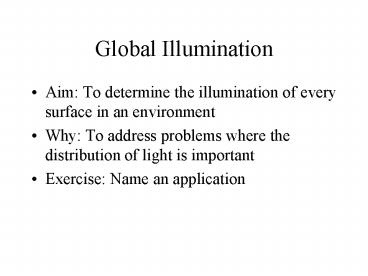Global Illumination - PowerPoint PPT Presentation
Title:
Global Illumination
Description:
Exercise: Name an application. What Is Light? ... Express as a string generated by the regular expression L(D|S)*E. Heckbert 90, S&P 7.3 ... – PowerPoint PPT presentation
Number of Views:24
Avg rating:3.0/5.0
Title: Global Illumination
1
Global Illumination
- Aim To determine the illumination of every
surface in an environment - Why To address problems where the distribution
of light is important - Exercise Name an application
2
What Is Light?
- Light is some range of the electromagnetic
spectrum - Emitters send out photons
- Some surfaces absorb
- Some surfaces scatter
- Aim Find out which photons enter the eye
3
Classifying Light Paths
- Assume a vacuum
- Each path from the light (L) to the eye (E)
consists of a series of diffuse (D) or specular
(S) bounces - Express as a string generated by the regular
expression L(DS)E - Heckbert 90, SP 7.3
- Exercise Classify paths in the following scene
4
Mirror S
Paint
Paint
Glass S
Cardboard D
L
D
D
D
Paint
5
Measuring Light
- Radiometry The study of light
- We are concerned about the light arriving at or
leaving a patch on the surface of an object - We will develop equations describing this
6
Solid Angle
- Place a hemisphere at each point on the surface
- The pattern of light on this hemisphere
determines the energy arriving or leaving that
point in every direction.
7
Hemisphere at a Point
8
Solid Angle
- Defined analogously to angle subtended by a line
segment at a point in the plane
9
Steradians
- Solid angle subtended by a patch at a point in 3D
Projected area onto a sphere centered on the
point - Solid angle cut out by infinitesimal steps
10
Radiance
- The distribution of light is a function of
position and direction. Think flashlight. - Usually denoted L(x, direction)
- Units Wm-2sr-1
Radiance is the amount of energy travelling at
some point in a specified direction, per unit
time, per unit area perpendicular to the
direction of travel, per unit solid angle
11
One Important Property
- In a vacuum, radiance is constant along straight
lines
12
Light at Surfaces
- Assumptions
- Radiance leaving is due only to radiance arriving
- Light leaving at some wavelength is due to light
incoming at that wavelength - Sources are treated separately
13
Irradiance
- The appropriate unit for representing incoming
power - Surface illuminated by radiance Li(x,?i,?i)
coming from differential region of solid angle d?
at angles (?i,?i) receives irradiance
Irradiance is the incident power per unit area
not foreshortened
Li(x,?i,?i)cos?i d?
14
BRDF
- Bidirectional reflectance distribution function
- For the previous example
The ratio of the radiance in the outgoing
direction to the incident irradiance
15
BRDF Properties
- Easy to compute radiance leaving due to
irradiance from one or all directions - Not an arbitrary symmetric function - cannot be
large in too many places - Depends on wavelength also, but we will mostly
ignore that







![Real-Time Volume Graphics [07] Global Volume Illumination PowerPoint PPT Presentation](https://s3.amazonaws.com/images.powershow.com/7513877.th0.jpg?_=20160105118)























